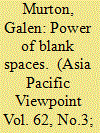| Srl | Item |
| 1 |
ID:
152970


|
|
|
|
|
| Summary/Abstract |
Infrastructure developments across the trans-Himalaya have rapidly advanced Nepali and Chinese state presences across spaces where central governance has long been absent. This study examines how new border infrastructures of fences and roads shape commercial and cultural relationships between Mustang (Nepal) and Tibet and the ways in which these processes serve state-making purposes for both Nepal and China through the governance of highland–borderland landscapes. A Tibetan cultural region at Nepal's northern border, Mustang's human and physical geography supports trade corridors that link the Tibetan Plateau with the plains of India. Merchants, mendicants and militaries have traversed these trade routes for centuries, giving rise to a unique social landscape that largely transcends modern demarcations of a bordered world. Looking across the trans-Himalaya, this article argues that as Chinese and Nepali authorities introduce new material structures and institutional practices to regulate and solidify the border between Tibet and Mustang, local communities are alternatively oriented towards either Kathmandu or Beijing under shifting terms of economic and political power.
|
|
|
|
|
|
|
|
|
|
|
|
|
|
|
|
| 2 |
ID:
182692


|
|
|
|
|
| Summary/Abstract |
A variety of maps depict a usefully approximate but inexact network of roads, rails, sea lanes and other infrastructures to represent something called China's Belt and Road Initiative (BRI). And yet, for a global programme that reflects and advances Beijing's new position as a leader of international development, BRI maps remain largely imprecise and unofficial. Taking this as a starting point of critical cartography, I ask why BRI development throughout the Tibet-Himalaya region remains conspicuously blank on most maps, and what work is accomplished by such cartographic silences. In contrast to this apparent invisibility, however, the BRI is very much present in Nepal – discursively, materially and cartographically. Chinese development programmes are widely anticipated, embraced and promoted as grand and spectacular things throughout Nepal. Following this friction of representation in the case of Chinese development in Nepal, I argue that the apparent paradox between the BRI as invisible thing and BRI as promised future reveals the manifold ways in which infrastructures articulate politics and, vice-versa, how politics articulate infrastructures.
|
|
|
|
|
|
|
|
|
|
|
|
|
|
|
|